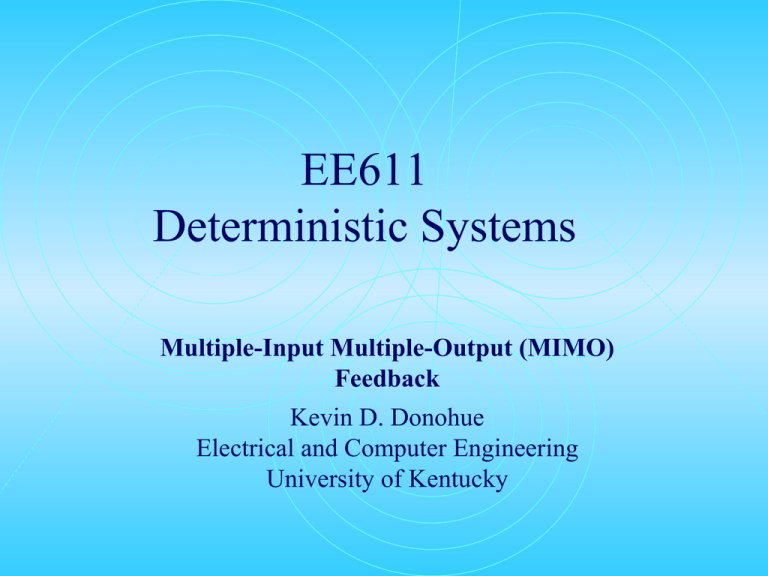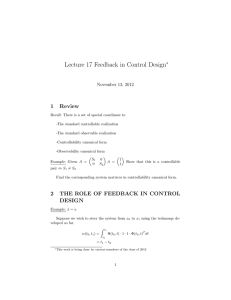EE611 Deterministic Systems Multiple-Input Multiple-Output (MIMO) Feedback
advertisement

EE611
Deterministic Systems
Multiple-Input Multiple-Output (MIMO)
Feedback
Kevin D. Donohue
Electrical and Computer Engineering
University of Kentucky
MIMO State Feedback
Consider designing state feedback for a MIMO system
ẋ=A xBut
yt =C xEut
Feedback design results in matrix K
u=r−K x
and the feedback compensated system becomes:
ẋ= A−B K xBrt
yt = C−E K xEr t
Design by Converting to Single Input System
Matrix A is cyclic iff its characteristic polynomial is equal to its
minimal polynomial (i.e. one and only one Jordan block for each
eigenvalue)
Theorem: If {A, B} is controllable and A is cyclic, then for
almost any px1 real vector v the single input pair {A, Bv } is
controllable.
“Almost” means rows of Bv corresponding to the last row of each
Jordan block are not zero.
[
] []
1 1 0 0
0 1 0 0
0 0 2 1
0 0 0 2
a
b
≠0
≠0
Creating Cyclic with Feedback
Theorem: If {A, B} is controllable, then for almost any
pxn real constant matrix K, all the eigenvalues of A–BK
are distinct and consequently (A-BK) is cyclic.
Theorem: If {A, B} is controllable, then by state
feedback of the form u = r - Kx where K is a pxn real
constant matrix, the eigenvalues of A-BK can be
arbitrarily assigned.
Feedback design process follows the proof ... If A not cyclic,
make it cyclic with an arbitrary feedback matrix, then design
another feedback matrix/vector to place eigenvalues at desired
positions.
Example
Convert Problem to single input system to design a
feedback matrix K to place eigenvalues at -2, -1.5±j1.5,
-1±j2
[ ][]
2
1
ẋ= 0
0
0
0
0
1
0
0
0
0
0
0
0
0
0
0
−2
1
0
1 0
0
0 0
u1
x
0
0 0
u
−1
0 1 2
0
0 0
[]
For reduction vector v = [1 1]T, show
[
K= 19.4 −19.5 45 −12.5 −15.8
19.4 −19.5 45 −12.5 −15.8
]
Design Using Controllable Canonical Form
Given controllable {A, B} with
B=[ b1 b 2 ... b p ]
Create initial controllability matrix:
M '=[ B A B ... A n− p B ]
where p is the rank of B. Obtain a non-singular square matrix M by finding
the l.i. columns from left to right of M' and rearrange to group together
columns of B:
[
M= b1 A b1 ... A
1−1
b 1 ⋮ b2 A b 2 ... A
2−1
b2 ⋮ ... ⋮ b p ... A
p −1
b p
]
where µi are the controllability indices associated with each l.i. column of B .
Take inverse of M and partition rows according to blocks associated with each
b i:
T
[
M−1 = e T11 e T21 ... e T 1 ⋮ e T12 e T22 ... e T 2 ⋮ ... ⋮ e T1 p ... e T
1
2
p
p
]
Design Using Controllable Canonical Form
Use last rows of each partition in M-1 to create P matrix for transformation to
controllable canonical form:
[]
e
e
0
0
⋮
1
0
...
...
⋰
...
...
0
1
⋮
0
0
p
p
A
...
−1
1 e p A
0
...
⋮
⋮
0
...
0
e 1
[ ]
0
0
P= ⋮
0
1
p
p
p
p
1
e 1 A
⋮
−1
e 1 A
1
1
1
MIMO Controllable Canonical Form
[
− p 1 − p 2
1
0
⋮
⋮
0
0
0
0
A= ⋮
⋮
x
x
0
0
⋮
⋮
0
0
0
0
... − p −2 − p −1
...
0
0
⋱
⋮
⋮
...
0
0
...
1
0
⋱
⋮
⋮
...
x
x
...
0
0
⋱
⋮
⋮
...
0
0
...
0
0
p
p
⋮
⋮
⋮
⋮
⋮
⋮
⋮
⋮
⋮
⋮
⋮
...
...
...
...
...
...
...
...
...
...
...
⋮ x
x
0
⋮ 0
⋮
⋮ ⋮
0
⋮ 0
0
⋮ 0
⋮
⋮ ⋮
⋮−11 −12
⋮ 1
0
⋮ ⋮
⋮
⋮ 0
0
⋮ 0
0
where x implies any number
...
x
x
...
0
0
⋱
⋮
⋮
...
0
0
...
0
0
⋱
⋮
⋮
... −1 −2 − 1 −1
...
0
0
⋱
⋮
⋮
...
0
0
...
1
0
1
1
][ ]
1
0
⋮
0
0
B= ⋮
0
0
⋮
0
0
...
...
⋮
...
...
⋮
...
...
⋮
...
...
x
0
⋮
0
0
⋮
1
0
⋮
0
0
Example
Convert the MIMO system below to a controllable
canonical form:
[
][ ]
−.4 .5 −22.2 −32.1 −11.2 12.3
4.8792
0 −.4 18.8 8.2
0
10.6
−4.8792
0
0 −21 −25
8
6
−.6099
ẋ=
x
0
0
20
19
−8 −1
1.2198
0
0
0
0
−2
2
−1.2198
0
0
0
0
−8 −2
2.4396
[
yt =
0
1
0 u1 t
−1 u2 t
0
0
[ ]
]
0.1007 0.0349 −0.7804 0.0349 6.0808 −1.4028
x
−0.0184 0.0203 8.7429 10.0203 0.9200 −2.2871
Example
Design a feedback matrix K so that resulting
eigenvalues are at -1, -2±j, and -1±j2
[ ][ ]
2
1
ẋ= 0
0
0
0
0
1
0
0
0 0 0
1 −.5
0 0 0
0 0
u1 t
x
0 0 0
0 0
u2 t
0 −2 −1
0 1
0 1 0
0 0
[
]
−1 1 0 2 3
y t =
x
0 0 1 0 1
[ ]
Lyapunov Method MIMO
Find equivalence transformation such that desired K
vector satisfies: T−1 A−B KT=F
where F is a matrix with desired eigenvalues distinct
from A (i.e. the eigenvalues of the feedback system).
Terms can be rearranged to show:
A T−T F=B K T
A T−T F=B K
can be chosen almost arbitrarily, and
Therefore, K
similarity transform matrix T solved for to obtain
−1
K= K T
Lyapunov Method MIMO
If A and F have no eigenvalues in common, then a
and is nonsingular
solution for T exists in A T−T F=B K
) observable.
iff (A, B ) is controllable and (F, K
Procedure:
1. Select n x n matrix F with desired eigenvalues.
2. Select arbitrary p x n vector l such that (F, l )
controllable.
3. Solve for T in the Lyapunov equation A T−T F=B K
4. Compute feedback gain matrix K= K
T−1
State Observer/Estimators
The extension from SISO to MIMO systems for state
observers is trivial for the Lyapunov method. Extend
single row vector c to C, and observer gain vector l to
L.
For the reduced state estimator, the observer can be
reduced to a dimension of n - ρ(C).







